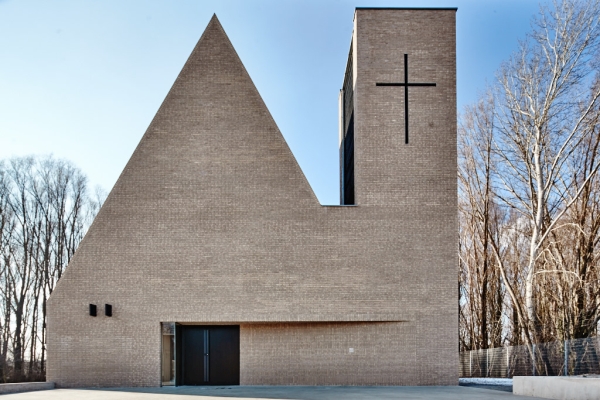Telluric power
The New St George’s Church in Józsa District, Debrecen
Architect: Zoltán Győrffy
Text: Tamás Meggyesi
Photos: Zsolt Batár

The newly built church primarily impresses the visitor via its gently proportionate mass and unique, homogeneous material qualities. The simple, acute-angled tent-roofed mass with a low parapet is harmoniously complemented by the structure of the belfry which appears somewhat bulky as a result of its proportions: it is does not actually evoke the image of a „campanile”, but the chimneys of peasant’s houses and even arc furnaces (which might be the very reason why we feel the building to be warm), whilst the bulk of the right-side aisle reminds us of the archetypal houses with an added porch. The character of the two masses almost merge complement and presuppose each other that their togetherness evokes the unity of the yang and yin, the female and male principles, i.e. that of coniunctio oppositorum. The whole development as such radiates natural warmth the harmony of which is intensified by the homogeneous finish: clinker facework which is hopefully continued inside. Whilst making a tour of the building we are further and pleasantly impressed as on a closer inspection one can see that the sensual, tactile texture of the bricks is wrinkled much in the same way as textiles tend to be, which is quite the contrary of what we usually experience. It seems to be made of an organic material which is also friendly to our senses. The designer himself has informed us that he wished to shape the whole building from a telluric material growing straight out of the earth. The same concept must have inspired the idea of using homogeneous finishes on both the exterior and interior of the church. Whilst the building is inevitably a contemporary design, it is able to evoke the coloeur de locale via its materials, its mass and proportions. As such, it is also a fine example of the practical implementation of Kenneth Frampton’s critical regionalism.
The church itself is actually small: the architectural programme was about to house a seating capacity for 200 people which has already proven to be insufficient on more than one occasion. However, even this number of visitors seems to have been too much for the designer: had he included all the pews in a single nave, they would have burst the building and, as a result, it would have lost the scale which actually makes it so homey and suited to its environment. The price that had to be paid for achieving this goal was the nave on the right side which pleasantly breaks up the symmetry of the whole mass, accepting the „auxiliary” character of its additive overall mass formation – whilst also permitting the positioning of some other complementary functions within here.
The clinker brick facework on the interior of the church has a highly smoothing effect on the interior of the church. One only realizes later on that the clinker bricks of the ceiling are not set in a flat plane: they follow a terraced configuration instead, which lends the surface a fairly gentle texture. It is a nice addition that the ambon as well as the tabernacle (opposed to the original intentions of the designer, but in my view, in a fortunate way) gently disturb the symmetry of the wall of the apse.
Józsa, a district of the city of Debrecen has now a new Catholic church which is one of the very few contemporary buildings featuring genuine values reaching far beyond the character of their creators. It bears slight references to the simplicity of early Modernist Swedish buildings, maybe the clinker architecture of works of Gunnar Asplund and Sigurd Lewerentz, which may not have been an accidental affinity considering the Protestant traditions of its context, the city of Debrecen. As a result, contemporary Hungarian ecclesiastic architecture has been enriched with a significant contribution.
Architect: Zoltán Győrffy
Fellow architects: János Kasuba, Attila Ferencz, Andrea Kocsel, István Benke
Structure: Sándor Haranghy, Zoltán Horváth
Framework: Richárd Reisch
Interiors: Ferenc Tündik
HVAC: Imre Szucskó
Electrical engineering: Péter Kálmán, István Kiss
Traffic: Imre Gulyás
Garden design: Tamás Sándor
Acoustics: Gusztáv Józsa
Main contractor: István Hajas – VitaBau Kft.
Project management: János Mogyorós, Attila Törös, Tamás Zsiros, László Vass, Gréti Gajdos
Client: Debrecen-Nyíregyházi Egyházmegye, Nándor Bosák bishop, László Felföldi vicar










